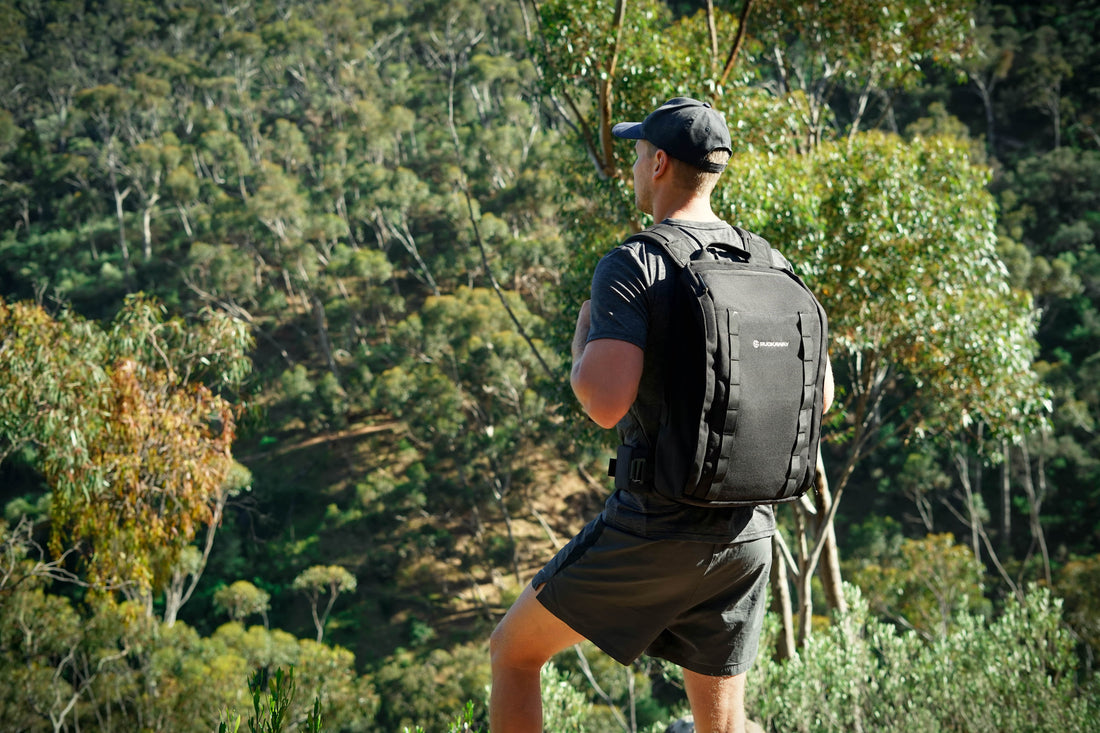RUCKING FOR BEGINNERS: THE ULTIMATE STEP-BY-STEP GUIDE

Share
Rucking strips fitness back to basics - just you, a weighted backpack, and movement. But like any training method, there's a right way to do it.
Load up your ruck too heavy? You'll burn out. Choose the wrong rucksack for rucking? Blisters and back pain are coming for you. Skip progression? You won't unlock rucking's full benefits.
This guide cuts through the noise to help you start rucking right and build lasting strength.
(Not sure exactly what rucking is or why it's worth doing? Read our guide to what is rucking first.)
STEP 1: CHOOSING YOUR RUCKING GEAR
The right gear can make or break your rucking experience. A proper rucking backpack isn't just a regular pack - it's built to handle heavy loads, maintain good posture, and keep you moving efficiently.
Finding the Perfect Rucking Backpack
Look for:
- Military-grade nylon and reinforced stitching for durability
- Wide, padded shoulder straps to prevent pressure points
- Sternum strap and hip belt to stabilize the load
- Dedicated weight compartments to keep your ruck secure
💡 Pro tip: If you're just testing the waters, a sturdy hiking backpack will work. But a dedicated rucksack for rucking is a game-changer when you're ready to commit.
Selecting Your Ruck Weight
The wrong type of weight can make rucking miserable. You need something compact and secure.
Best options:
- Rucking weights - flat, dense weights designed for the job
- Sandbags - if packed properly and secured
What to avoid:
- Loose weights that shift around
- Anything with sharp edges
- Items that distribute weight poorly
Footwear Matters
Your rucking backpack carries the load, but your feet do the work. Choose:
- Trail running shoes or lightweight hiking boots for varied terrain
- High-cushion trainers for pavement
- Avoid flat gym shoes (no support) or heavy boots (unnecessary weight)
STEP 2: LOADING YOUR RUCK RIGHT
A poorly packed ruck throws off your balance and strains your back. Here's how to do it right:
- Position weight high and close to your spine
- Secure everything to prevent shifting
- Tighten straps to keep the pack close to your body
💡 Pro tip: The hip belt is your friend - use it for longer rucks to shift weight to your legs, or remove it for more upper body work. You should maintain tall posture. If you're hunching, drop the weight.
STEP 3: MASTER YOUR RUCKING FORM
Good form prevents injuries and builds endurance. Here's what you're aiming for:
The basics:
- Stand tall - imagine a string pulling you up
- Keep shoulders back, chest up
- Engage your core without tensing
- Look forward, not down
- Let your arms swing naturally
Common mistakes to avoid:
- Hunching under weight (reduce load if you can't stay upright)
- Letting your rucking backpack bounce (tighten those straps)
- Taking huge strides (keep steps natural)
- Gripping straps too tight (stay relaxed up top)
💡 Pro tip: If your shoulders burn mid-ruck, loosen the shoulder straps slightly to shift more weight to your hips. Once recovered, tighten back up.
STEP 4: BUILD YOUR RUCKING BASE
Start here:
- Weight: 5kg (under 70kg body weight), 5-10kg (70-90kg depending on fitness level), or 10-15kg (over 90kg or strong fitness background)
- Distance: 2-3km
- Pace: Brisk walk (12-15 min per km)
- Frequency: 2x per week
The goal isn't to max out - it's to build a foundation. If you can't hold a conversation during your ruck, dial it back.
STEP 5: LEVEL UP YOUR RUCKING
Once the basics feel solid, progress smart:
- Master 5-6km before adding weight
- Increase your ruck load in 5kg increments
- Mix up terrain - hills, trails, sand
- Add strength training to support your rucking:
- Goblet squats for leg and core strength
- Deadlifts for back and hamstrings
- Step-ups for real-world movement patterns
- Farmer's carries for grip and posture
Time to Move
Remember - rucking isn't complicated, but starting right makes all the difference. Get your rucking backpack sorted, focus on form, and progress gradually. Consistency beats intensity every time.
Questions? Drop us a line at hello@ruckaway.com - we're always keen to help fellow ruckers on their journey.
Now lace up, load up your ruck, and see what you're capable of.


